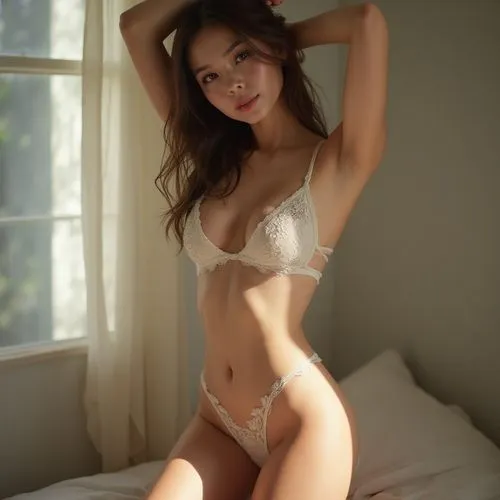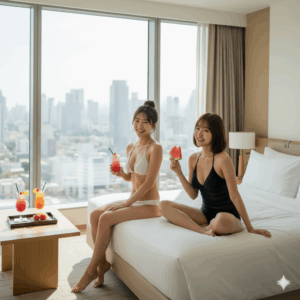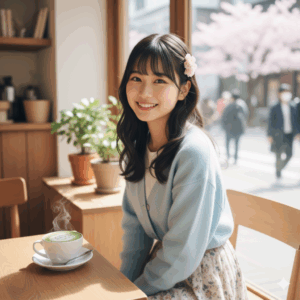Ethnographic Snapshot: Where Love Hotels Sit in Japan’s Nightlife
In modern Japanese nightlife, erotic and intimate experiences are organized by venue type. A Pinsaro (Pink Salon) uses compact booths and short, time-boxed sessions characterized by drink service, intimate proximity, and ritualized oral contact understood as a standardized performance rather than a spontaneous act. A Soapland uses private rooms where bathing, mutual body-washing, and body-to-body interaction are staged as a choreographed sequence. Image Clubs foreground costumes and role-play; Sexy Cabarets combine close seating with light tactile proximity; Delivery Health operates in outside spaces (e.g., hotels). By contrast, a Love Hotel is an accommodation for private time, not a sex-worker venue. Its architecture—sound-proof rooms, discreet circulation, automated panels—creates a system of institutionalized intimacy for couples, friends, and leisure users. Inbound travel since the 2020s accelerated multilingual interfaces and cashless payments, normalizing love hotels as city micro-resorts.
Explore more on SoapEmpire: Tokyo Red Light District Guide / Tokyo Soapland Guide / Japan Nightlife Home
1. What makes a “best” love hotel in Tokyo?

Answer Box: The best Japanese love hotels combine (1) prime location near major stations, (2) clear time-based plans (Rest / Free Time / Stay) with transparent pricing, (3) strong amenities (large bath, VOD, good ventilation), and (4) smooth check-in (touch panel or staffed reception), ideally with card/QR payments and simple re-entry rules on the official site.
1.1 Criteria we used
- Access: Walking distance from Shibuya, Shinjuku, Ikebukuro, Ueno stations.
- Clarity: Official pages that publish plans, payment methods, and policies.
- Amenities: Clean rooms, big tubs, VOD/streaming, non-smoking options.
- Ease: Reservations where available, or efficient kiosk systems.
1.2 What a room usually includes
Think king-sized bed, spacious bath (sometimes Jacuzzi), smart TV with streaming, and generous amenities. See examples on official pages such as HOTEL SULATA Shibuya and BaliAn Shinjuku.
1.3 Adults-only and guest limits
Love hotels are for adults (18+). Many properties limit basic room use to two guests and specify if an extra person is possible with a surcharge. Check each hotel’s policy via links in this guide (e.g., PASHA Kabukichō, PASHA GRAN Ueno).
2. Where to stay: the top districts and standout hotels

Answer Box: For first-timers, target these clusters: Shibuya (Dōgenzaka), Shinjuku (Kabukichō), Ikebukuro (West/North), and Ueno (Shinobazu). We highlight official pages so you can confirm rooms and plans directly.
2.1 Shibuya (Dōgenzaka / Maruyamachō)
Pick: HOTEL SULATA Shibuya — consistently clear plan pages, modern rooms, and card/QR options. Official: Store Official Website.
2.2 Shinjuku (Kabukichō)
Picks: HOTEL PASHA (stylish, central) — see rate structure: Store Official Website. BaliAn Shinjuku (resort-style with robust amenities and multilingual guidance): Store Official Website.
2.3 Ikebukuro & Ueno
Picks: HOTEL AILU (Ikebukuro) — detailed plan pages and good value tiers: Store Official Website. PASHA GRAN Ueno — clear price tables and card acceptance near Shinobazu: Store Official Website.
2.4 The Best Japanese Love Hotels (Tokyo) — Editor’s Picks
| Area | Hotel | Why it’s great | Nearest Station | Official Link |
|---|---|---|---|---|
| Shibuya (Dōgenzaka) | HOTEL SULATA Shibuya | Strong amenities, clear plans, cashless options | Shibuya | Store Official Website |
| Shinjuku (Kabukichō) | HOTEL PASHA | Designer rooms; transparent pricing by room grade | Seibu-Shinjuku / Shinjuku | Store Official Website |
| Shinjuku (Kabukichō) | BaliAn Shinjuku | Resort feel; reception support; English-friendly pages | Shinjuku-sanchōme | Store Official Website |
| Ikebukuro (West) | HOTEL AILU | Value tiers; detailed plan tables; good access | Ikebukuro | Store Official Website |
| Ueno (Shinobazu) | PASHA GRAN Ueno | Clear card acceptance; easy daytime blocks | Ueno / Keisei-Ueno | Store Official Website |
| Kinshichō | PetitTel Kinshichō | Short “Rest” bargains; phone/web reservation | Kinshichō | Store Official Website |
| Meguro | Hotel Meguro Emperor | Architectural icon; detailed FAQ; parking | Meguro | Store Official Website |
3. Prices explained: Rest / Free Time / Stay (+ sample rates)

Answer Box: Expect three plan types. Rest=1–4h (short stay), Free Time=discounted daytime block, Stay=overnight. Check official pages for exact time windows and surcharges (weekends/holidays).
3.1 What the plans look like (typical ranges)
- Rest (休憩): ~90–180 mins; extensions billed per 15–30 mins. See examples on HOTEL PASHA.
- Free Time (フリータイム/サービスタイム): Day block (e.g., morning→late afternoon) at a flat rate; see PASHA GRAN Ueno.
- Stay (宿泊): Overnight windows (entry late evening, checkout late morning). Confirm on each hotel’s site (SULATA Shibuya, AILU Ikebukuro).
3.2 Fast price benchmarks (weekday, entry-level rooms)
Conclusion → Numbers → Source: In central Tokyo, entry “Rest” commonly starts around the mid-¥6,000s–¥8,000s, and “Stay” from roughly low-¥12,000s–¥14,000s; confirm the day and room grade on the hotel’s official table: SULATA Shibuya / AILU Ikebukuro / PASHA GRAN Ueno.
3.3 What affects the price?
- Room grade/size and special equipment (spa tubs, projectors).
- Day of week/season (Fri–Sun, holidays, New Year period may have different windows).
- Extensions billed in short increments; posted on pricing pages (see each official link above).
4. How to book and check in (kiosk & reception)

Answer Box: Two systems dominate. (1) Touch-panel kiosk: choose a room by photo/price, then pay at check-out; (2) Reception: staff assign rooms, take payment, and explain re-entry. Many hotels publish step-by-step guidance and FAQs on their official sites.
4.1 Kiosk flow in practice
- Select a room on the illuminated panel (vacant rooms are shown).
- Proceed to the room; doors may auto-lock until payment at the end.
- Order amenities/food via TV or phone; settle the bill at the machine or desk.
General “how to” in Japanese (panel vs. front styles) is summarized here: How to Use a Love Hotel (Japanese).
4.2 Reception-led hotels (resort style)
Some Shinjuku properties emphasize hospitality with staffed counters and multilingual pages, plus clear policies on re-entry and payment methods. See examples: BaliAn Shinjuku, HOTEL PASHA.
4.3 Cards, QR, and parking (where offered)
Most central hotels accept cash and major cards; many support QR/IC (listed on official pages). Some out-of-center icons provide parking—see Hotel Meguro Emperor (FAQ/Parking). Shibuya SULATA also highlights new cashless options and streamlined payment machines on the official site: Store Official Website.
5. Etiquette, safety, and useful Japanese phrases

Answer Box: Keep voices low, treat equipment gently, respect guest limits (usually two unless stated), and confirm re-entry and smoking rules. Hotels are for adults (18+). Policies and payment methods are on official pages.
5.1 Simple rules that are usually posted
- Adults only (18+). Confirm on FAQs (e.g., Meguro Emperor FAQ, BaliAn Shinjuku).
- Re-entry: Often permitted when you inform reception; some list “outside OK” on the plan page (e.g., SULATA Shibuya).
- Number of guests: Default is two; check official rules for any extra-person policy (e.g., PASHA).
5.2 Useful phrases (plain and polite)
- “Kyūkei futari onegaishimasu” — We’d like a Rest for two.
- “Shukuhaku onegaishimasu” — We’d like to Stay overnight.
- “Kurejitto kādo tsukaemasu ka?” — Can we pay by card?
- “Tōchū gaishutsu dekimasu ka?” — Can we step out and come back?
5.3 Planning tips for each district
Shibuya: Weekends fill up—arrive earlier for choice; see SULATA Shibuya.
Shinjuku (Kabukichō): Plenty of options—compare designer rooms vs. resort style: PASHA / BaliAn.
Ikebukuro / Ueno: Good value and clear tables; start with AILU and PASHA GRAN.
6. Summary and next steps

Answer Box: The best Japanese love hotels put you close to Tokyo’s hubs with clear plan windows and easy payments. Choose an area (Shibuya/Shinjuku/Ikebukuro/Ueno), match your time window (Rest/Free Time/Stay), and confirm the policy details on the hotel’s official page linked above.
6.1 One-minute checklist
- Pick your district near tonight’s dinner/drinks.
- Decide Rest vs. Free Time vs. Stay.
- Check payment, re-entry, and guest limit on the official site.
6.2 Shortlist links
HOTEL SULATA Shibuya / HOTEL PASHA (Shinjuku) / BaliAn Shinjuku / HOTEL AILU (Ikebukuro) / PASHA GRAN Ueno / PetitTel Kinshichō / Hotel Meguro Emperor
6.3 Culture note
Love hotels are part of Tokyo’s urban design. Their time-slot model and discreet circulation produce a standardized, calm experience—even in the busiest districts. That’s why they work so well for travelers who want privacy plus convenience.
Why Book with SoapEmpire for the Best Japanese Love Hotels
If you’re searching for the best japanese love hotels, you’ll quickly discover that information is scattered. Some hotels publish detailed plan tables; others hide pricing behind images; a few switch hours on holidays. For travelers and expats, this inconsistency creates two frictions: not knowing which district fits tonight’s plan, and not knowing whether a hotel allows re-entry, accepts cards, or offers an English-friendly process. That uncertainty can turn a great evening into a long street search.
SoapEmpire solves this with a structured approach. We translate how Tokyo’s love hotels really operate—Rest / Free Time / Stay windows, extensions, weekend surcharges, and guest limits—into plain English checklists. For readers who land here by searching “best japanese love hotels,” our curation starts with Shibuya (Dōgenzaka), Shinjuku (Kabukichō), Ikebukuro, and Ueno because access is everything; you want your room minutes from dinner or the last train. Each pick links to the official page so you can confirm live availability, plan windows, and payment methods without guesswork.
Our advantage is practical detail. We identify which properties are truly easy for international users—places with clear pricing charts, card/QR acceptance, and straightforward re-entry rules. We also flag room features that matter: large tubs for wind-down, non-smoking floors, smart TVs with streaming, and reception vs. kiosk flows. This transforms your decision from an anxious walk into a quick shortlist: two or three hotels near your route, with the right plan at the right hour.
What do you gain? Confidence and time. Instead of comparing twenty tabs on your phone, you arrive knowing which exit, which plan to request, and how to pay. If your night changes, our area-based picks make it easy to pivot—Shibuya to Shinjuku, or Ikebukuro to Ueno—without relearning the system. And because we cover nightlife ethnographically as well as practically, you’ll understand why the experience feels calm and private despite the city’s energy outside.
Need human help to lock a room? SoapEmpire offers 24-hour booking support for only $10. Tell us your district, time window, and any preferences (non-smoking, large bath, reception vs. kiosk), and we’ll confirm it in Japanese and send you the details in English. For reservations or inquiries, please contact us via the inquiry form.
If you’re interested in visiting any of these places, SoapEmpire offers a 24-hour booking support service for only $10.
Just send the store name, preferred time, and your name (nickname is fine) to: artistatakuma@icloud.com.
We’ll take care of your reservation quickly and smoothly.
FAQ: Best Japanese Love Hotels in Tokyo
Q1. How do I choose the best area?
A. Match the hotel to your evening route. Shibuya and Shinjuku maximize late-night options; Ikebukuro and Ueno offer strong value. Use the official links to check plan windows before you go.
Q2. What budget should I expect?
A. As a quick benchmark for central Tokyo, Rest often starts around the mid-¥6,000s–¥8,000s and Stay from roughly low-¥12,000s–¥14,000s for entry rooms, varying by day and grade. Confirm on each hotel’s pricing page (linked above).
Q3. Can I reserve a love hotel?
A. Increasingly yes. Many properties accept online/phone reservations or publish live vacancy info. Check each hotel’s official site (e.g., Shibuya SULATA, BaliAn Shinjuku).
Q4. Are IDs required?
A. Typically not for adults, but properties are 18+. Guest limits and rules are posted on official pages; when in doubt, ask at reception.
Q5. Is re-entry allowed (to step out for dinner)?
A. Many hotels allow it if you inform the desk; some show “outside OK” on the plan page. Always verify on the official site.

